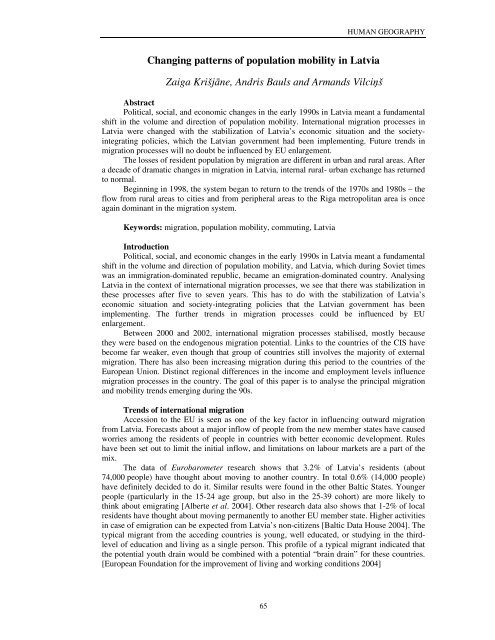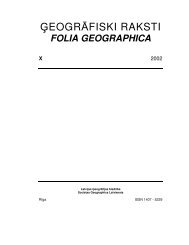eogrÄfiski raksti folia geographica xii - Ä¢eogrÄfijas un Zemes zinÄtņu ...
eogrÄfiski raksti folia geographica xii - Ä¢eogrÄfijas un Zemes zinÄtņu ...
eogrÄfiski raksti folia geographica xii - Ä¢eogrÄfijas un Zemes zinÄtņu ...
Create successful ePaper yourself
Turn your PDF publications into a flip-book with our unique Google optimized e-Paper software.
Changing patterns of population mobility in Latvia<br />
Zaiga Krišjāne, Andris Bauls and Armands Vilciņš<br />
65<br />
HUMAN GEOGRAPHY<br />
Abstract<br />
Political, social, and economic changes in the early 1990s in Latvia meant a f<strong>un</strong>damental<br />
shift in the volume and direction of population mobility. International migration processes in<br />
Latvia were changed with the stabilization of Latvia’s economic situation and the societyintegrating<br />
policies, which the Latvian government had been implementing. Future trends in<br />
migration processes will no doubt be influenced by EU enlargement.<br />
The losses of resident population by migration are different in urban and rural areas. After<br />
a decade of dramatic changes in migration in Latvia, internal rural- urban exchange has returned<br />
to normal.<br />
Beginning in 1998, the system began to return to the trends of the 1970s and 1980s – the<br />
flow from rural areas to cities and from peripheral areas to the Riga metropolitan area is once<br />
again dominant in the migration system.<br />
Keywords: migration, population mobility, commuting, Latvia<br />
Introduction<br />
Political, social, and economic changes in the early 1990s in Latvia meant a f<strong>un</strong>damental<br />
shift in the volume and direction of population mobility, and Latvia, which during Soviet times<br />
was an immigration-dominated republic, became an emigration-dominated co<strong>un</strong>try. Analysing<br />
Latvia in the context of international migration processes, we see that there was stabilization in<br />
these processes after five to seven years. This has to do with the stabilization of Latvia’s<br />
economic situation and society-integrating policies that the Latvian government has been<br />
implementing. The further trends in migration processes could be influenced by EU<br />
enlargement.<br />
Between 2000 and 2002, international migration processes stabilised, mostly because<br />
they were based on the endogenous migration potential. Links to the co<strong>un</strong>tries of the CIS have<br />
become far weaker, even though that group of co<strong>un</strong>tries still involves the majority of external<br />
migration. There has also been increasing migration during this period to the co<strong>un</strong>tries of the<br />
European Union. Distinct regional differences in the income and employment levels influence<br />
migration processes in the co<strong>un</strong>try. The goal of this paper is to analyse the principal migration<br />
and mobility trends emerging during the 90s.<br />
Trends of international migration<br />
Accession to the EU is seen as one of the key factor in influencing outward migration<br />
from Latvia. Forecasts about a major inflow of people from the new member states have caused<br />
worries among the residents of people in co<strong>un</strong>tries with better economic development. Rules<br />
have been set out to limit the initial inflow, and limitations on labour markets are a part of the<br />
mix.<br />
The data of Eurobarometer research shows that 3.2% of Latvia’s residents (about<br />
74,000 people) have thought about moving to another co<strong>un</strong>try. In total 0.6% (14,000 people)<br />
have definitely decided to do it. Similar results were fo<strong>un</strong>d in the other Baltic States. Yo<strong>un</strong>ger<br />
people (particularly in the 15-24 age group, but also in the 25-39 cohort) are more likely to<br />
think about emigrating [Alberte et al. 2004]. Other research data also shows that 1-2% of local<br />
residents have thought about moving permanently to another EU member state. Higher activities<br />
in case of emigration can be expected from Latvia’s non-citizens [Baltic Data House 2004]. The<br />
typical migrant from the acceding co<strong>un</strong>tries is yo<strong>un</strong>g, well educated, or studying in the thirdlevel<br />
of education and living as a single person. This profile of a typical migrant indicated that<br />
the potential youth drain would be combined with a potential “brain drain” for these co<strong>un</strong>tries.<br />
[European Fo<strong>un</strong>dation for the improvement of living and working conditions 2004]

















